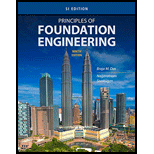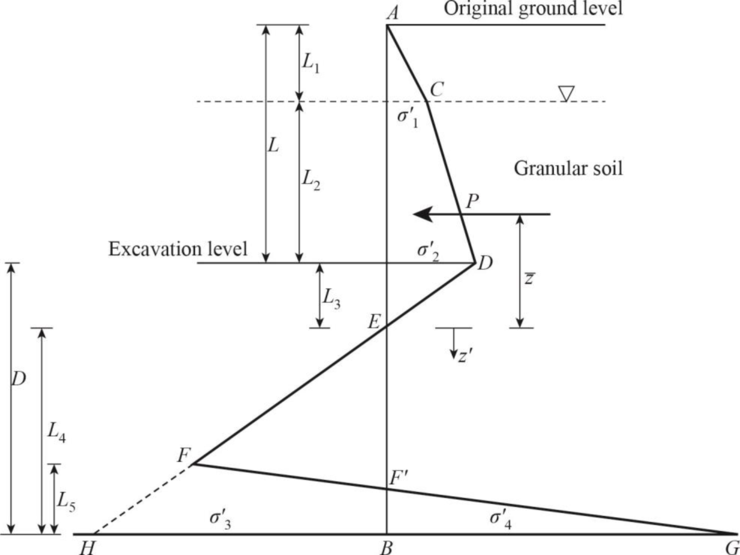
Concept explainers
Refer to Figure 18.9. A cantilever sheet pile is driven into a granular soil where the water table is 2 m (L1) below the top of the sand. The properties of the sand are
Find the required actual depth of the sheet pile.
Answer to Problem 18.1P
The required actual depth of the sheet pile is
Explanation of Solution
Given information:
The depth of water level below the sand
The angle of internal friction for sand
The unit weight of the sand
The saturated unit weight of the sand
The depth below the ground level (L) is 6 m.
Calculation:
Show the cross section of cantilever sheet pile with dimensions as in Figure (1).

Refer Figure (1),
Find the depth of water table level
Find the rankine active pressure coefficient
Find the rankine passive pressure coefficient
Find the difference between the rankine active pressure coefficient and rankine passive pressure coefficient:
Find the effective unit weight of sand
At the water table level:
Find the intensity of the active pressure to the right of the pile
At the excavation level:
Find the intensity of the active pressure to the right of the pile
Find the depth below the dredge line
Find the area of the pressure diagram (P):
Find the area of the pressure diagram into center of pressure
Find the center of pressure to the area
Find the intensity of the passive pressure
Find the area
Find the area
Find the area
Find the area
Find the depth below point E
Use trial and error method to calculate depth below point E
Try
Substitute 4.30 m for
Hence, the assumption is correct.
The depth below point E is 4.30 m.
Find the depth below the dredge line to bottom of the pile (D):
Increase the depth below the dredge line to bottom of the pile by 30%. The depth below the dredge line to bottom of the pile (D) is 6.214 m.
Find required actual depth of the sheet pile
Thus, the required actual depth of the sheet pile is
Want to see more full solutions like this?
Chapter 18 Solutions
Principles Of Foundation Engineering 9e
- QUESTION 2-(40 Points) In the case where other information is given in the figure, the wall is under the effect of a uniform lateral wind load of 0.7 kN/m2. Since the foundation is sized according to the safe bearing capacity of the soil and the safe bearing capacity remains the same, find the width of this foundation asymmetrically (with uniform base pressure). Draw the vertical section of the wall of the asymmetric foundation and write its dimensions and values on it. Draw the T and M diagrams along the width. The foundation thickness is the same in both cases. q=0.7 kN/m2 5 m R Duvar Nd=Wd 0.7 m T K 0 0.6 0.5 1.7 m Yb-24 kN/m3 0.6 m T + foundationarrow_forwardCan you pls. Explain on how to get "BETA T" and "BETA C" on this study about VALUE OF TRAVEL TIME.arrow_forward440 CHAPTER 9 ANALYSIS OF STATICALLY INDETERMIN 9-23. Determine the reactions at the supports, then draw the moment diagrams for each member. Assume A and B are pins and the joint at C is fixed connected. EI is constant. Se 9-2 12 kN 2 m 2 m 6 kN/m A 6 m Prob. 9-23 Barrow_forward
- I need a solution to this problemarrow_forwardThree forces act on the ring. If the resultant force FR has a magnitude and direction as shown, determine the magnitude and the coordinate direction angles of force F3. == F2 = 110 N F3 F₁ = 80 N 3 X 45° FR = 120 N 30° yarrow_forwardFIND the CENTROID and the MOMENT OF INERTIA through the centroidal x axisarrow_forward
- (b) For the cantilever beam shown in Fig. 3, a roller support has been added at mid-span. Given that El is constant, use the force method to determine the following: (i) The reaction force at support C. (ii) The reaction forces at fixed support A. (15 marks) C 25 kN B 2 m 2 m Fig. 3: A propped cantilever beam [Q2=25 marks]arrow_forwardYou are working on a 1-km highway extension project that requires the construction of a 4-m tall soil embankment with a top width of 15-m and 2H:1V slopes. A borrow-pit (i.e., a place where soils are excavated, to then be placed elsewhere for construction projects) has been identified with e = 0.74, emax = 0.9, emin = 0.5. To avoid excessive road deformations, the soil will be compacted to a relative density of DR = 90% when placed in the embankment. Your boss estimates that extracting 100,000 m^3 of material from the borrow-pit should be enough for this project. Is your boss correct, or is more material than that needed? To decide, answer these questions: a) What volume of soil, as placed, is required to build the embankment? [Tip: draw the embankment] b) What is the void ratio of the material when placed in the embankment? c) What is the relative density of the material in the borrow-pit? d) When soil is extracted from the borrow-pit and then compacted it the embankment, how do…arrow_forwardThere are 20 cars traveling at constant speeds on a 1 mile long ring track and the cars can pass each other freely. On the track 25% of the cars are traveling at 20 mph, 50% of the cars are traveling 10 mph, and the remaining 25% of the cars are traveling at an unknown speed. It was known that the space mean speed of all the cars on the track is 20 mph. (a) What is the speed that the remaining 25% of cars are traveling at? (b) If an observer standing on the side of the track counted the number and measured the speed of all cars that passed her for one hour, what is the time-mean speed of all the cars the observer counted? (c) What is the flow rate measured by the observer? (d) What is the car density on the track? Does density times space mean speed equal flow rate?arrow_forward
- 2.21 A small truck is to be driven down a 4% grade at 70 mi/h. The coefficient of road adhesion is 0.95, and it is known that the braking efficiency is 80% when the truck is empty and decreases by one percentage point for every 100 lb of cargo added. Ignoring aerodynamic resistance, if the driver wants the truck to be able to achieve a minimum theoretical stopping distance of 275 ft from the point of brake application, what is the maximum amount of cargo (in pounds) that can be carried?arrow_forwardAn observer standing beside a one-lane road counted in 5 minutes 20 cars traveling at 30 mph, 30 cars traveling at 50 mph and 10 cars traveling at 60 mph. (a) What is the space and time-mean speeds of the observed cars? (b) What is the average headway of the cars? [arrow_forward2.20 A driver is traveling at 90 mi/h down a 3% grade on good, wet pavement. An accident investigation team noted that braking skid marks started 410 ft before a parked car was hit at an estimated 45 mi/h. Ignoring air resistance, and using theoretical stopping distance, what was the braking efficiency of the car?arrow_forward
 Principles of Foundation Engineering (MindTap Cou...Civil EngineeringISBN:9781305081550Author:Braja M. DasPublisher:Cengage Learning
Principles of Foundation Engineering (MindTap Cou...Civil EngineeringISBN:9781305081550Author:Braja M. DasPublisher:Cengage Learning Fundamentals of Geotechnical Engineering (MindTap...Civil EngineeringISBN:9781305635180Author:Braja M. Das, Nagaratnam SivakuganPublisher:Cengage Learning
Fundamentals of Geotechnical Engineering (MindTap...Civil EngineeringISBN:9781305635180Author:Braja M. Das, Nagaratnam SivakuganPublisher:Cengage Learning Principles of Foundation Engineering (MindTap Cou...Civil EngineeringISBN:9781337705028Author:Braja M. Das, Nagaratnam SivakuganPublisher:Cengage Learning
Principles of Foundation Engineering (MindTap Cou...Civil EngineeringISBN:9781337705028Author:Braja M. Das, Nagaratnam SivakuganPublisher:Cengage Learning Principles of Geotechnical Engineering (MindTap C...Civil EngineeringISBN:9781305970939Author:Braja M. Das, Khaled SobhanPublisher:Cengage Learning
Principles of Geotechnical Engineering (MindTap C...Civil EngineeringISBN:9781305970939Author:Braja M. Das, Khaled SobhanPublisher:Cengage Learning



